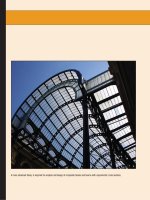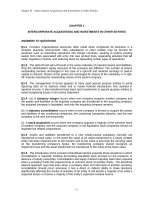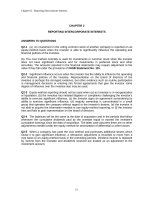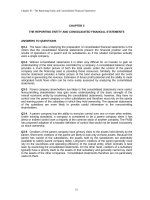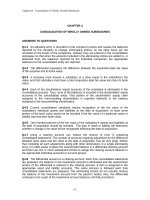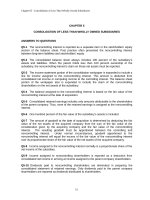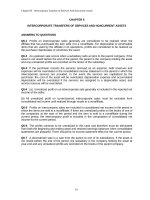Solution manual mechanics of materials 8th edition hibbeler chapter 08
Bạn đang xem bản rút gọn của tài liệu. Xem và tải ngay bản đầy đủ của tài liệu tại đây (10.47 MB, 87 trang )
08 Solutions 46060
5/28/10
8:34 AM
Page 532
© 2010 Pearson Education, Inc., Upper Saddle River, NJ. All rights reserved. This material is protected under all copyright laws as they currently
exist. No portion of this material may be reproduced, in any form or by any means, without permission in writing from the publisher.
8–1. A spherical gas tank has an inner radius of r = 1.5 m.
If it is subjected to an internal pressure of p = 300 kPa,
determine its required thickness if the maximum normal
stress is not to exceed 12 MPa.
pr
;
2t
sallow =
12(106) =
300(103)(1.5)
2t
t = 0.0188 m = 18.8 mm
Ans.
8–2. A pressurized spherical tank is to be made of
0.5-in.-thick steel. If it is subjected to an internal pressure
of p = 200 psi, determine its outer radius if the maximum
normal stress is not to exceed 15 ksi.
sallow =
pr
;
2t
15(103) =
200 ri
2(0.5)
ri = 75 in.
ro = 75 in. + 0.5 in. = 75.5 in.
Ans.
8–3. The thin-walled cylinder can be supported in one of
two ways as shown. Determine the state of stress in the wall
of the cylinder for both cases if the piston P causes the
internal pressure to be 65 psi. The wall has a thickness of
0.25 in. and the inner diameter of the cylinder is 8 in.
P
Case (a):
s1 =
pr
;
t
s1 =
65(4)
= 1.04 ksi
0.25
Ans.
s2 = 0
Ans.
Case (b):
s1 =
pr
;
t
s1 =
65(4)
= 1.04 ksi
0.25
Ans.
s2 =
pr
;
2t
s2 =
65(4)
= 520 psi
2(0.25)
Ans.
532
P
8 in.
8 in.
(a)
(b)
08 Solutions 46060
5/28/10
8:34 AM
Page 533
© 2010 Pearson Education, Inc., Upper Saddle River, NJ. All rights reserved. This material is protected under all copyright laws as they currently
exist. No portion of this material may be reproduced, in any form or by any means, without permission in writing from the publisher.
*8–4. The tank of the air compressor is subjected to an
internal pressure of 90 psi. If the internal diameter of
the tank is 22 in., and the wall thickness is 0.25 in.,
determine the stress components acting at point A. Draw a
volume element of the material at this point, and show the
results on the element.
Hoop Stress for Cylindrical Vessels: Since
A
11
r
=
= 44 7 10, then thin wall
t
0.25
analysis can be used. Applying Eq. 8–1
s1 =
pr
90(11)
=
= 3960 psi = 3.96 ksi
t
0.25
Ans.
Longitudinal Stress for Cylindrical Vessels: Applying Eq. 8–2
s2 =
pr
90(11)
=
= 1980 psi = 1.98 ksi
2t
2(0.25)
Ans.
•8–5.
The spherical gas tank is fabricated by bolting together
two hemispherical thin shells of thickness 30 mm. If the gas
contained in the tank is under a gauge pressure of 2 MPa,
determine the normal stress developed in the wall of the tank
and in each of the bolts.The tank has an inner diameter of 8 m
and is sealed with 900 bolts each 25 mm in diameter.
Normal Stress: Since
4
r
=
= 133.33 7 10, thin-wall analysis is valid. For the
t
0.03
spherical tank’s wall,
s =
Referring
pr
2(4)
=
= 133 MPa
2t
2(0.03)
to
the
free-body
diagram
p 2
6
P = pA = 2 A 10 B c A 8 B d = 32p A 10 B N. Thus,
4
Ans.
shown
in
Fig.
a,
6
+ c ©Fy = 0;
32p A 106 B - 450Pb - 450Pb = 0
Pb = 35.56 A 103 B p N
The normal stress developed in each bolt is then
sb =
35.56 A 103 B p
Pb
=
= 228 MPa
p
Ab
A 0.0252 B
4
Ans.
533
08 Solutions 46060
5/28/10
8:34 AM
Page 534
© 2010 Pearson Education, Inc., Upper Saddle River, NJ. All rights reserved. This material is protected under all copyright laws as they currently
exist. No portion of this material may be reproduced, in any form or by any means, without permission in writing from the publisher.
8–6. The spherical gas tank is fabricated by bolting
together two hemispherical thin shells. If the 8-m inner
diameter tank is to be designed to withstand a gauge pressure
of 2 MPa, determine the minimum wall thickness of the
tank and the minimum number of 25-mm diameter bolts
that must be used to seal it. The tank and the bolts are made
from material having an allowable normal stress of 150 MPa
and 250 MPa, respectively.
Normal Stress: For the spherical tank’s wall,
sallow =
pr
2t
150 A 106 B =
2 A 106 B (4)
2t
t = 0.02667 m = 26.7 mm
Since
Ans.
r
4
=
= 150 7 10, thin-wall analysis is valid.
t
0.02667
Referring
the
free-body
diagram
p
P = pA = 2 A 106 B c A 82 B d = 32p A 106 B N. Thus,
4
+ c ©Fy = 0;
to
32p A 106 B n =
shown
in
Fig.
a,
n
n
(P )
- (Pb)allow = 0
2 b allow
2
32p A 106 B
(1)
(Pb)allow
The allowable tensile force for each bolt is
(Pb)allow = sallowAb = 250 A 106 B c
p
A 0.0252 B d = 39.0625 A 103 B pN
4
Substituting this result into Eq. (1),
n =
32p A 106 B
39.0625p A 103 B
= 819.2 = 820
Ans.
534
08 Solutions 46060
5/28/10
8:34 AM
Page 535
© 2010 Pearson Education, Inc., Upper Saddle River, NJ. All rights reserved. This material is protected under all copyright laws as they currently
exist. No portion of this material may be reproduced, in any form or by any means, without permission in writing from the publisher.
8–7. A boiler is constructed of 8-mm thick steel plates that
are fastened together at their ends using a butt joint
consisting of two 8-mm cover plates and rivets having a
diameter of 10 mm and spaced 50 mm apart as shown. If the
steam pressure in the boiler is 1.35 MPa, determine (a) the
circumferential stress in the boiler’s plate apart from
the seam, (b) the circumferential stress in the outer cover plate
along the rivet line a–a, and (c) the shear stress in the rivets.
a
8 mm
50 mm
a)
s1 =
pr
1.35(106)(0.75)
=
= 126.56(106) = 127 MPa
t
0.008
Ans.
126.56 (106)(0.05)(0.008) = s1 ¿(2)(0.04)(0.008)
b)
s1 ¿ = 79.1 MPa
Ans.
c) From FBD(a)
+ c ©Fy = 0;
Fb - 79.1(106)[(0.008)(0.04)] = 0
Fb = 25.3 kN
(tavg)b =
Fb
25312.5
- p
= 322 MPa
2
A
4 (0.01)
Ans.
535
0.75 m
a
08 Solutions 46060
5/28/10
8:34 AM
Page 536
© 2010 Pearson Education, Inc., Upper Saddle River, NJ. All rights reserved. This material is protected under all copyright laws as they currently
exist. No portion of this material may be reproduced, in any form or by any means, without permission in writing from the publisher.
*8–8. The gas storage tank is fabricated by bolting together
two half cylindrical thin shells and two hemispherical shells
as shown. If the tank is designed to withstand a pressure
of 3 MPa, determine the required minimum thickness of
the cylindrical and hemispherical shells and the minimum
required number of longitudinal bolts per meter length at
each side of the cylindrical shell. The tank and the 25 mm
diameter bolts are made from material having an allowable
normal stress of 150 MPa and 250 MPa, respectively. The
tank has an inner diameter of 4 m.
Normal Stress: For the cylindrical portion of the tank, the hoop stress is twice as
large as the longitudinal stress.
sallow =
pr
;
t
150 A 106 B =
3 A 106 B (2)
tc
tc = 0.04 m = 40 mm
For the hemispherical cap,
sallow
pr
=
;
t
150 A 10
6
B =
Ans.
3 A 106 B (2)
2ts
ts = 0.02 m = 20 mm
Since
Ans.
r
6 10, thin-wall analysis is valid.
t
Referring to the free-body diagram of the per meter length of the cylindrical
portion, Fig. a, where P = pA = 3 A 106 B [4(1)] = 12 A 106 B N, we have
+ c ©Fy = 0;
12 A 106 B - nc(Pb)allow - nc(Pb)allow = 0
nc =
6 A 106 B
(1)
(Pb)allow
The allowable tensile force for each bolt is
(Pb)allow = sallowAb = 250 A 106 B c
p
A 0.0252 B d = 122.72 A 103 B N
4
Substituting this result into Eq. (1),
nc = 48.89 = 49 bolts>meter
Ans.
536
08 Solutions 46060
5/28/10
8:34 AM
Page 537
© 2010 Pearson Education, Inc., Upper Saddle River, NJ. All rights reserved. This material is protected under all copyright laws as they currently
exist. No portion of this material may be reproduced, in any form or by any means, without permission in writing from the publisher.
•8–9.
The gas storage tank is fabricated by bolting together
two half cylindrical thin shells and two hemispherical shells
as shown. If the tank is designed to withstand a pressure of
3 MPa, determine the required minimum thickness of the
cylindrical and hemispherical shells and the minimum
required number of bolts for each hemispherical cap. The
tank and the 25 mm diameter bolts are made from material
having an allowable normal stress of 150 MPa and 250 MPa,
respectively. The tank has an inner diameter of 4 m.
Normal Stress: For the cylindrical portion of the tank, the hoop stress is twice as
large as the longitudinal stress.
sallow =
pr
;
t
150 A 106 B =
3 A 106 B (2)
tc
tc = 0.04 m = 40 mm
For the hemispherical cap,
sallow =
pr
;
t
150 A 106 B =
Ans.
3 A 106 B (2)
2ts
ts = 0.02 m = 20 mm
Since
Ans.
r
6 10, thin-wall analysis is valid.
t
The allowable tensile force for each bolt is
(Pb)allow = sallowAb = 250 A 106 B c
p
A 0.0252 B d = 122.72 A 103 B N
4
Referring to the free-body diagram of the hemispherical cap, Fig. b, where
p
P = pA = 3 A 106 B c A 42 B d = 12p A 106 B N,
4
+ ©F = 0;
:
x
12p A 106 B ns =
ns
ns
(Pb)allow (Pb)allow = 0
2
2
12p A 106 B
(1)
(Pb)allow
Substituting this result into Eq. (1),
ns = 307.2 = 308 bolts
Ans.
537
08 Solutions 46060
5/28/10
8:34 AM
Page 538
© 2010 Pearson Education, Inc., Upper Saddle River, NJ. All rights reserved. This material is protected under all copyright laws as they currently
exist. No portion of this material may be reproduced, in any form or by any means, without permission in writing from the publisher.
8–10. A wood pipe having an inner diameter of 3 ft is
bound together using steel hoops each having a crosssectional area of 0.2 in2. If the allowable stress for the hoops
is sallow = 12 ksi, determine their maximum spacing s along
the section of pipe so that the pipe can resist an internal
gauge pressure of 4 psi. Assume each hoop supports the
pressure loading acting along the length s of the pipe.
s
4 psi
4 psi
s
s
Equilibrium for the steel Hoop: From the FBD
+ ©F = 0;
:
x
P = 72.0s
2P - 4(36s) = 0
Hoop Stress for the Steel Hoop:
s1 = sallow =
12(103) =
P
A
72.0s
0.2
s = 33.3 in.
Ans.
8–11. The staves or vertical members of the wooden tank
are held together using semicircular hoops having a
thickness of 0.5 in. and a width of 2 in. Determine the normal
stress in hoop AB if the tank is subjected to an internal
gauge pressure of 2 psi and this loading is transmitted
directly to the hoops. Also, if 0.25-in.-diameter bolts are used
to connect each hoop together, determine the tensile stress
in each bolt at A and B. Assume hoop AB supports the
pressure loading within a 12-in. length of the tank as shown.
18 in.
6 in.
6 in.
FR = 2(36)(12) = 864 lb
©F = 0; 864 - 2F = 0; F = 432 lb
sh =
sb =
F
432
=
= 432 psi
Ah
0.5(2)
Ans.
F
432
=
= 8801 psi = 8.80 ksi
p
Ab
(0.25)2
4
Ans.
538
12 in.
A
B
12 in.
08 Solutions 46060
5/28/10
8:34 AM
Page 539
© 2010 Pearson Education, Inc., Upper Saddle River, NJ. All rights reserved. This material is protected under all copyright laws as they currently
exist. No portion of this material may be reproduced, in any form or by any means, without permission in writing from the publisher.
*8–12. Two hemispheres having an inner radius of 2 ft and
wall thickness of 0.25 in. are fitted together, and the inside
gauge pressure is reduced to -10 psi. If the coefficient
of static friction is ms = 0.5 between the hemispheres,
determine (a) the torque T needed to initiate the rotation
of the top hemisphere relative to the bottom one, (b) the
vertical force needed to pull the top hemisphere off
the bottom one, and (c) the horizontal force needed to slide
the top hemisphere off the bottom one.
0.25 in.
2 ft
Normal Pressure: Vertical force equilibrium for FBD(a).
+ c ©Fy = 0;
10 C p(242) D - N = 0
N = 5760p lb
The Friction Force: Applying friction formula
Ff = ms N = 0.5(5760p) = 2880p lb
a) The Required Torque: In order to initiate rotation of the two hemispheres
relative to each other, the torque must overcome the moment produced by the
friction force about the center of the sphere.
T = Ffr = 2880p(2 + 0.125>12) = 18190 lb # ft = 18.2 kip # ft
Ans.
b) The Required Vertical Force: In order to just pull the two hemispheres apart, the
vertical force P must overcome the normal force.
P = N = 5760p = 18096 lb = 18.1 kip
Ans.
c) The Required Horizontal Force: In order to just cause the two hemispheres to
slide relative to each other, the horizontal force F must overcome the friction force.
F = Ff = 2880p = 9048 lb = 9.05 kip
Ans.
•8–13. The 304 stainless steel band initially fits snugly around
the smooth rigid cylinder. If the band is then subjected to a
nonlinear temperature drop of ¢T = 20 sin2 u °F, where u is
in radians, determine the circumferential stress in the band.
1
64
10 in.
Compatibility: Since the band is fixed to a rigid cylinder (it does not deform under
load), then
dF - dT = 0
2p
P(2pr)
a¢Trdu = 0
AE
L0
2pr P
a b = 20ar
E A
L0
2p
s = 10a
E c
L0
2p
sin2 udu
however,
P
= sc
A
2p
(1 - cos 2u)du
sc = 10aE
= 10(9.60) A 10 - 6 B 28.0 A 103 B = 2.69 ksi
Ans.
539
u
in.
1 in.
08 Solutions 46060
5/28/10
8:34 AM
Page 540
© 2010 Pearson Education, Inc., Upper Saddle River, NJ. All rights reserved. This material is protected under all copyright laws as they currently
exist. No portion of this material may be reproduced, in any form or by any means, without permission in writing from the publisher.
8–14. The ring, having the dimensions shown, is placed
over a flexible membrane which is pumped up with a
pressure p. Determine the change in the internal radius of
the ring after this pressure is applied. The modulus of
elasticity for the ring is E.
ro
ri
w
p
Equilibrium for the Ring: Form the FBD
+ ©F = 0;
:
x
2P - 2pri w = 0
P = pri w
Hoop Stress and Strain for the Ring:
s1 =
pri w
pri
P
=
=
rs - ri
A
(rs - ri)w
Using Hooke’s Law
e1 =
However,
e1 =
pri
s1
=
E
E(rs - ri)
[1]
2p(ri)1 - 2pri
(ri)1 - ri
dri
=
=
.
ri
ri
2pr
Then, from Eq. [1]
pri
dri
=
ri
E(rs - ri)
dri =
pr2i
E(rs - ri)
Ans.
540
08 Solutions 46060
5/28/10
8:34 AM
Page 541
© 2010 Pearson Education, Inc., Upper Saddle River, NJ. All rights reserved. This material is protected under all copyright laws as they currently
exist. No portion of this material may be reproduced, in any form or by any means, without permission in writing from the publisher.
8–15. The inner ring A has an inner radius r1 and outer
radius r2. Before heating, the outer ring B has an inner
radius r3 and an outer radius r4, and r2 7 r3. If the outer ring
is heated and then fitted over the inner ring, determine the
pressure between the two rings when ring B reaches the
temperature of the inner ring. The material has a modulus of
elasticity of E and a coefficient of thermal expansion of a.
r1
A
Equilibrium for the Ring: From the FBD
+ ©F = 0;
:
x
P = priw
2P - 2priw = 0
Hoop Stress and Strain for the Ring:
s1 =
priw
pri
P
=
=
ro - ri
A
(ro - ri)w
Using Hooke’s law
e1 =
However,
e1 =
pri
s1
=
E
E(ro - ri)
[1]
2p(ri)1 - 2pri
(ri)1 - ri
dri
=
=
.
ri
ri
2pr
Then, from Eq. [1]
pri
dri
=
ri
E(ro - ri)
dri =
pr2i
E(ro - ri)
Compatibility: The pressure between the rings requires
dr2 + dr3 = r2 - r3
[2]
From the result obtained above
dr2 =
pr22
E(r2 - r1)
dr3 =
pr23
E(r4 - r3)
Substitute into Eq. [2]
pr22
pr23
+
= r2 - r3
E(r2 - r1)
E(r4 - r3)
p =
r4
r2
E(r2 - r3)
Ans.
r22
r23
+
r2 - r1
r4 - r3
541
r3
B
08 Solutions 46060
5/28/10
8:34 AM
Page 542
© 2010 Pearson Education, Inc., Upper Saddle River, NJ. All rights reserved. This material is protected under all copyright laws as they currently
exist. No portion of this material may be reproduced, in any form or by any means, without permission in writing from the publisher.
*8–16. The cylindrical tank is fabricated by welding a
strip of thin plate helically, making an angle u with the
longitudinal axis of the tank. If the strip has a width w and
thickness t, and the gas within the tank of diameter d is
pressured to p, show that the normal stress developed along
the strip is given by su = (pd>8t)(3 - cos 2u).
w
u
Normal Stress:
sh = s1 =
pr
p(d>2)
pd
=
=
t
t
2t
sl = s2 =
p(d>2)
pd
pr
=
=
2t
2t
4t
Equilibrium: We will consider the triangular element cut from the strip
shown in Fig. a. Here,
Ah = (w sin u)t
and
Thus,
Al = (w cos u)t.
pd
pwd
and
(w sin u)t =
sin u
Fh = shAh =
2t
2
pwd
pd
(w cos u)t =
cos u.
4t
4
Fl = slAl =
Writing the force equation of equilibrium along the x¿ axis,
©Fx¿ = 0;
c
pwd
pwd
sin u d sin u + c
cos u d cos u - Nu = u
2
4
Nu =
pwd
A 2 sin2 u + cos2 u B
4
However, sin2 u + cos2 u = 1. This equation becomes
Nu =
Also, sin2 u =
pwd
A sin2 u + 1 B
4
1
(1 - cos 2u), so that
2
pwd
Nu =
(3 - cos 2u)
8
Since Au = wt, then
Nu
=
su =
Au
su =
pwd
(3 - cos 2u)
8
wt
pd
(3 - cos 2u)
8t
(Q.E.D.)
542
08 Solutions 46060
5/28/10
8:34 AM
Page 543
© 2010 Pearson Education, Inc., Upper Saddle River, NJ. All rights reserved. This material is protected under all copyright laws as they currently
exist. No portion of this material may be reproduced, in any form or by any means, without permission in writing from the publisher.
8–17. In order to increase the strength of the pressure vessel,
filament winding of the same material is wrapped around the
circumference of the vessel as shown. If the pretension in the
filament is T and the vessel is subjected to an internal pressure
p, determine the hoop stresses in the filament and in the wall
of the vessel. Use the free-body diagram shown, and assume
the filament winding has a thickness tЈ and width w for a
corresponding length of the vessel.
L
w
s1
t¿
T
p
t
s1
T
Normal Stress in the Wall and Filament Before the Internal Pressure is Applied:
The entire length w of wall is subjected to pretension filament force T. Hence, from
equilibrium, the normal stress in the wall at this state is
2T - (sl ¿)w (2wt) = 0
(sl ¿)w =
T
wt
and for the filament the normal stress is
(sl ¿)fil =
T
wt¿
Normal Stress in the Wall and Filament After the Internal Pressure is Applied: The
stress in the filament becomes
sfil = sl + (sl ¿)fil =
pr
T
+
(t + t¿)
wt¿
Ans.
sw = sl - (sl ¿)w =
pr
T
(t + t¿)
wt
Ans.
And for the wall,
8–18. The vertical force P acts on the bottom of the plate
having a negligible weight. Determine the shortest distance
d to the edge of the plate at which it can be applied so that
it produces no compressive stresses on the plate at section
a–a. The plate has a thickness of 10 mm and P acts along the
center line of this thickness.
300 mm
a
a
200 mm
500 mm
sA = 0 = sa - sb
0 =
0 =
P
Mc
A
I
P
(0.2)(0.01)
d
P(0.1 - d)(0.1)
1
12
P
(0.01)(0.23)
P(-1000 + 15000 d) = 0
d = 0.0667 m = 66.7 mm
Ans.
543
08 Solutions 46060
5/28/10
8:34 AM
Page 544
© 2010 Pearson Education, Inc., Upper Saddle River, NJ. All rights reserved. This material is protected under all copyright laws as they currently
exist. No portion of this material may be reproduced, in any form or by any means, without permission in writing from the publisher.
8–19. Determine the maximum and minimum normal
stress in the bracket at section a–a when the load is applied
at x = 0.
100 kN
15 mm
x
15 mm
200 mm
150 mm
a
Consider the equilibrium of the FBD of the top cut segment in Fig. a,
+ c ©Fy = 0;
a + ©MC = 0;
N - 100 = 0
N = 100 kN
100(0.1) - M = 0
A = 0.2(0.03) = 0.006 m2
I =
M = 10 kN # m
1
(0.03)(0.23) = 20.0(10 - 6) m4
12
The normal stress developed is the combination of axial and bending stress. Thus,
s =
My
N
;
A
I
For the left edge fiber, y = C = 0.1 m. Then
sL = -
100(103)
10(103)(0.1)
0.006
20.0(10 - 6)
= -66.67(106) Pa = 66.7 MPa (C) (Max)
Ans.
For the right edge fiber, y = 0.1 m. Then
sR = -
100 (103)
10(103)(0.1)
= 33.3 MPa (T)
+
0.006
20.0(10 - 6)
Ans.
544
a
08 Solutions 46060
5/28/10
8:34 AM
Page 545
© 2010 Pearson Education, Inc., Upper Saddle River, NJ. All rights reserved. This material is protected under all copyright laws as they currently
exist. No portion of this material may be reproduced, in any form or by any means, without permission in writing from the publisher.
*8–20. Determine the maximum and minimum normal
stress in the bracket at section a–a when the load is applied
at x = 300 mm.
100 kN
15 mm
x
15 mm
200 mm
150 mm
a
Consider the equilibrium of the FBD of the top cut segment in Fig. a,
+ c ©Fy = 0;
a + ©MC = 0;
N - 100 = 0
N = 100 kN
M - 100(0.2) = 0
A = 0.2 (0.03) = 0.006 m2
I =
M = 20 kN # m
1
(0.03)(0.23) = 20.0(10 - 6) m4
12
The normal stress developed is the combination of axial and bending stress. Thus,
s =
My
N
;
A
I
For the left edge fiber, y = C = 0.1 m. Then
sC = -
100(103)
20.0(103)(0.1)
+
0.006
20.0(10 - 6)
= 83.33(106) Pa = 83.3 MPa (T)(Min)
Ans.
For the right edge fiber, y = C = 0.1 m. Thus
sR = -
100(103)
20.0(103)(0.1)
0.006
20.0(10 - 6)
= 117 MPa
Ans.
545
a
08 Solutions 46060
5/28/10
8:34 AM
Page 546
© 2010 Pearson Education, Inc., Upper Saddle River, NJ. All rights reserved. This material is protected under all copyright laws as they currently
exist. No portion of this material may be reproduced, in any form or by any means, without permission in writing from the publisher.
•8–21.
The coping saw has an adjustable blade that is
tightened with a tension of 40 N. Determine the state of
stress in the frame at points A and B.
8 mm
75 mm
A
3 mm
8 mm
3 mm
B
100 mm
50 mm
sA = -
sB =
P
Mc
40
+
= +
A
I
(0.008)(0.003)
Mc
=
I
2(0.004)
1
12
(0.003)(0.008)3
4(0.004)
1
3
12 (0.003)(0.008)
= 123 MPa
Ans.
Ans.
= 62.5 MPa
8–22. The clamp is made from members AB and AC,
which are pin connected at A. If it exerts a compressive
force at C and B of 180 N, determine the maximum
compressive stress in the clamp at section a–a. The screw EF
is subjected only to a tensile force along its axis.
30 mm
40 mm
F
C
180 N
15 mm
15 mm
Section a – a
a
a
B
A
E
There is no moment in this problem. Therefore, the compressive stress is produced
by axial force only.
smax =
P
240
=
= 1.07 MPa
A
(0.015)(0.015)
Ans.
546
180 N
08 Solutions 46060
5/28/10
8:34 AM
Page 547
© 2010 Pearson Education, Inc., Upper Saddle River, NJ. All rights reserved. This material is protected under all copyright laws as they currently
exist. No portion of this material may be reproduced, in any form or by any means, without permission in writing from the publisher.
8–23. The clamp is made from members AB and AC,
which are pin connected at A. If it exerts a compressive
force at C and B of 180 N, sketch the stress distribution
acting over section a–a. The screw EF is subjected only to
a tensile force along its axis.
30 mm
40 mm
F
C
180 N
15 mm
15 mm
Section a – a
a
a
180 N
B
A
E
There is moment in this problem. Therefore, the compressive stress is produced by
axial force only.
smax =
240
P
=
= 1.07 MPa
A
(0.015)(0.015)
*8–24. The bearing pin supports the load of 700 lb.
Determine the stress components in the support member
at point A. The support is 0.5 in. thick.
0.75 in.
A
2 in.
30Њ
A
B
3 in.
©Fx = 0;
N - 700 cos 30° = 0;
N = 606.218 lb
©Fy = 0;
V - 700 sin 30° = 0;
V = 350 lb
a + ©M = 0;
M - 700(1.25 - 2 sin 30°) = 0;
sA =
1.25 in.
700 lb
M = 175 lb # in.
(175)(0.375)
N
Mc
606.218
=
- 1
3
A
I
(0.75)(0.5)
12 (0.5)(0.75)
sA = -2.12 ksi
Ans.
tA = 0
Ans.
(since QA = 0)
547
B
0.5 in.
08 Solutions 46060
5/28/10
8:34 AM
Page 548
© 2010 Pearson Education, Inc., Upper Saddle River, NJ. All rights reserved. This material is protected under all copyright laws as they currently
exist. No portion of this material may be reproduced, in any form or by any means, without permission in writing from the publisher.
•8–25.
The bearing pin supports the load of 700 lb.
Determine the stress components in the support member
at point B. The support is 0.5 in. thick.
0.75 in.
A
2 in.
30Њ
A
B
B
0.5 in.
3 in.
©Fx = 0;
N - 700 cos 30° = 0;
N = 606.218 lb
©Fy = 0;
V - 700 sin 30° = 0;
V = 350 lb
a + ©M = 0;
M - 700(1.25 - 2 sin 30°) = 0;
sB =
N
Mc
606.218
+
=
+
A
I
(0.75)(0.5)
1.25 in.
700 lb
M = 175 lb # in.
175(0.375)
1
12
(0.5)(0.75)3
sB = 5.35 ksi
Ans.
tB = 0
Ans.
(since QB = 0)
8–26. The offset link supports the loading of P = 30 kN.
Determine its required width w if the allowable normal
stress is sallow = 73 MPa. The link has a thickness of 40 mm.
P
s due to axial force:
sa =
30(103)
750(103)
P
=
=
A
(w)(0.04)
w
sb =
w
50 mm
s due to bending:
30(103)(0.05 + w2)(w2)
Mc
=
1
3
I
12 (0.04)(w)
4500 (103)(0.05 + w2)
=
w2
P
smax = sallow = sa + sb
73(106) =
4500(103)(0.05 + w2)
750(103)
+
w
w2
73 w2 = 0.75 w + 0.225 + 2.25 w
73 w2 - 3 w - 0.225 = 0
w = 0.0797 m = 79.7 mm
Ans.
548
08 Solutions 46060
5/28/10
8:34 AM
Page 549
© 2010 Pearson Education, Inc., Upper Saddle River, NJ. All rights reserved. This material is protected under all copyright laws as they currently
exist. No portion of this material may be reproduced, in any form or by any means, without permission in writing from the publisher.
8–27. The offset link has a width of w = 200 mm and a
thickness of 40 mm. If the allowable normal stress is
sallow = 75 MPa, determine the maximum load P that can
be applied to the cables.
P
A = 0.2(0.04) = 0.008 m2
I =
s =
1
(0.04)(0.2)3 = 26.6667(10 - 6) m4
12
w
50 mm
P
Mc
+
A
I
75(106) =
0.150 P(0.1)
P
+
0.008
26.6667(10 - 6)
P = 109 kN
Ans.
P
*8–28. The joint is subjected to a force of P ϭ 80 lb and
F ϭ 0. Sketch the normal-stress distribution acting over
section a–a if the member has a rectangular cross-sectional
area of width 2 in. and thickness 0.5 in.
a
B
s due to axial force:
s =
0.5 in.
P
80
=
= 80 psi
A
(0.5)(2)
2 in.
F
s due to bending:
s =
A a
100(0.25)
Mc
= 1
= 1200 psi
3
I
12 (2)(0.5)
1.25 in.
P
(smax)t = 80 + 1200 = 1280 psi = 1.28 ksi
Ans.
(smax)c = 1200 - 80 = 1120 psi = 1.12 ksi
Ans.
y
(0.5 - y)
=
1.28
1.12
y = 0.267 in.
549
08 Solutions 46060
5/28/10
8:34 AM
Page 550
© 2010 Pearson Education, Inc., Upper Saddle River, NJ. All rights reserved. This material is protected under all copyright laws as they currently
exist. No portion of this material may be reproduced, in any form or by any means, without permission in writing from the publisher.
The joint is subjected to a force of P = 200 lb and
F = 150 lb. Determine the state of stress at points A and B
and sketch the results on differential elements located at
these points. The member has a rectangular cross-sectional
area of width 0.75 in. and thickness 0.5 in.
•8–29.
a
B
A a
0.5 in.
2 in.
F
1.25 in.
P
A = 0.5(0.75) = 0.375 in2
œ
QA = yA
A¿ = 0.125(0.75)(0.25) = 0.0234375 in3 ;
I =
QB = 0
1
(0.75)(0.53) = 0.0078125 in4
12
Normal Stress:
My
N
;
A
I
s =
sA =
200
+ 0 = 533 psi (T)
0.375
Ans.
sB =
50(0.25)
200
= -1067 psi = 1067 psi (C)
0.375
0.0078125
Ans.
Shear stress:
t =
VQ
It
tA =
150(0.0234375)
= 600 psi
(0.0078125)(0.75)
Ans.
tB = 0
Ans.
550
08 Solutions 46060
5/28/10
8:34 AM
Page 551
© 2010 Pearson Education, Inc., Upper Saddle River, NJ. All rights reserved. This material is protected under all copyright laws as they currently
exist. No portion of this material may be reproduced, in any form or by any means, without permission in writing from the publisher.
8–30. If the 75-kg man stands in the position shown,
determine the state of stress at point A on the cross section
of the plank at section a–a. The center of gravity of the man
is at G. Assume that the contact point at C is smooth.
C
G
600 mm
A
a
50 mm
1.5 m
B
12.5 mm
30Њ a
600 mm
300 mm
Support Reactions: Referring to the free-body diagram of the entire plank, Fig. a,
a + ©MB = 0;
FC sin 30°(2.4) - 75(9.81) cos 30°(0.9) = 0
FC = 477.88 N
©Fx¿ = 0; Bx¿ - 75(9.81) sin 30° - 477.88 cos 30° = 0
Bx¿ = 781.73 N
©Fy¿ = 0; By¿ + 477.88 sin 30° - 75(9.81) cos 30° = 0
By¿ = 398.24 N
Internal Loadings: Consider the equilibrium of the free-body diagram of the plank’s
lower segment, Fig. b,
©Fx¿ = 0; 781.73 - N = 0
N = 781.73 N
©Fy¿ = 0; 398.24 - V = 0
V = 398.24 N
a + ©MO = 0;
M - 398.24(0.6) = 0
M = 238.94 N # m
Section Properties: The cross-sectional area and the moment of inertia about the
centroidal axis of the plank’s cross section are
A = 0.6(0.05) = 0.03 m2
I =
1
(0.6) A 0.053 B = 6.25 A 10 - 6 B m4
12
Referring to Fig. c, QA is
QA = y¿A¿ = 0.01875(0.0125)(0.6) = 0.140625 A 10 - 3 B m3
Normal Stress: The normal stress is the combination of axial and bending stress.
Thus,
s =
My
N
;
A
I
For point A, y = 0.0125 m. Then
sA =
238.94(0.0125)
-781.73
0.03
6.25 A 10 - 6 B
= -503.94 kPa = 504 kPa (C)
Ans.
551
Section a – a and b – b
08 Solutions 46060
5/28/10
8:34 AM
Page 552
© 2010 Pearson Education, Inc., Upper Saddle River, NJ. All rights reserved. This material is protected under all copyright laws as they currently
exist. No portion of this material may be reproduced, in any form or by any means, without permission in writing from the publisher.
8–30.
Continued
Shear Stress: The shear stress is contributed by transverse shear stress. Thus,
tA
VQA
=
=
It
398.24 c0.140625 A 10 - 3 B d
6.25 A 10 - 6 B (0.6)
Ans.
= 14.9 kPa
The state of stress at point A is represented on the element shown in Fig. d.
552
08 Solutions 46060
5/28/10
8:34 AM
Page 553
© 2010 Pearson Education, Inc., Upper Saddle River, NJ. All rights reserved. This material is protected under all copyright laws as they currently
exist. No portion of this material may be reproduced, in any form or by any means, without permission in writing from the publisher.
8–31. Determine the smallest distance d to the edge of the
plate at which the force P can be applied so that it produces
no compressive stresses in the plate at section a–a. The
plate has a thickness of 20 mm and P acts along the
centerline of this thickness.
a
P
200 mm
d
300 mm
a
Consider the equilibrium of the FBD of the left cut segment in Fig. a,
+
: ©Fx = 0;
N - P = 0
a + ©MC = 0;
N = P
M - P(0.1 - d) = 0
A = 0.2 (0.02) = 0.004 m4
I =
M = P(0.1 - d)
1
(0.02)(0.23) = 13.3333(10 - 6) m4
12
The normal stress developed is the combination of axial and bending stress. Thus
s =
My
N
;
A
I
Since no compressive stress is desired, the normal stress at the top edge fiber must
be equal to zero. Thus,
0 =
P(0.1 - d)(0.1)
P
;
0.004
13.3333 (10 - 6)
0 = 250 P - 7500 P (0.1 - d)
d = 0.06667 m = 66.7 mm
Ans.
553
08 Solutions 46060
5/28/10
8:34 AM
Page 554
© 2010 Pearson Education, Inc., Upper Saddle River, NJ. All rights reserved. This material is protected under all copyright laws as they currently
exist. No portion of this material may be reproduced, in any form or by any means, without permission in writing from the publisher.
*8–32. The horizontal force of P = 80 kN acts at the end
of the plate. The plate has a thickness of 10 mm and P acts
along the centerline of this thickness such that d = 50 mm.
Plot the distribution of normal stress acting along
section a–a.
a
P
200 mm
d
300 mm
Consider the equilibrium of the FBD of the left cut segment in Fig. a,
+
: ©Fx = 0;
a + ©MC = 0;
N - 80 = 0
N = 80 kN
M - 80(0.05) = 0
A = 0.01(0.2) = 0.002 m2
I =
M = 4.00 kN # m
1
(0.01)(0.23) = 6.667(10 - 6) m4
12
The normal stress developed is the combination of axial and bending stress. Thus,
s =
My
N
;
A
I
At point A, y = 0.1 m. Then
sA =
80(103)
4.00(103)(0.1)
0.002
6.667(10 - 6)
= -20.0(106) Pa = 20.0 Mpa (C)
At point B, y = 0.1 m. Then
sB =
80(103)
4.00(103)(0.1)
+
0.002
6.667(10 - 6)
= 100 (106) Pa = 100 MPa (T)
The location of neutral axis can be determined using the similar triangles.
554
a
08 Solutions 46060
5/28/10
8:34 AM
Page 555
© 2010 Pearson Education, Inc., Upper Saddle River, NJ. All rights reserved. This material is protected under all copyright laws as they currently
exist. No portion of this material may be reproduced, in any form or by any means, without permission in writing from the publisher.
•8–33.
The pliers are made from two steel parts pinned
together at A. If a smooth bolt is held in the jaws and a
gripping force of 10 lb is applied at the handles, determine
the state of stress developed in the pliers at points B and C.
Here the cross section is rectangular, having the dimensions
shown in the figure.
0.18 in.
10 lb
D
0.2 in.
0.1 in.
D
3 in.
30Њ
E
A B
0.2 in.
0.2 in.
B
E
C
C
0.2 in.
1.75 in.
2.5 in.
Q ©Fx = 0;
N - 10 sin 30° = 0;
N = 5.0 lb
a+ ©Fy = 0;
V - 10 cos 30° = 0;
V = 8.660 lb
+
a + ©MC = 0;
10 lb
M = 30 lb # in.
M - 10(3) = 0
A = 0.2(0.4) = 0.08 in2
I =
1
(0.2)(0.43) = 1.0667(10 - 3) in4
12
QB = 0
QC = y¿A¿ = 0.1(0.2)(0.2) = 4(10 - 3) in3
Point B:
sB =
My
30(0.2)
N
-5.0
= 5.56 ksi(T)
+
=
+
A
I
0.08
1.0667(10 - 3)
Ans.
VQ
= 0
It
Ans.
My
N
-5.0
+
=
+ 0 = -62.5 psi = 62.5 psi(C)
A
I
0.08
Ans.
VQ
8.660(4)(10 - 3)
= 162 psi
=
It
1.0667(10 - 3)(0.2)
Ans.
tB =
Point C:
sC =
Shear Stress :
tC =
4 in.
555
08 Solutions 46060
5/28/10
8:34 AM
Page 556
© 2010 Pearson Education, Inc., Upper Saddle River, NJ. All rights reserved. This material is protected under all copyright laws as they currently
exist. No portion of this material may be reproduced, in any form or by any means, without permission in writing from the publisher.
8–34.
Solve Prob. 8–33 for points D and E.
0.18 in.
10 lb
D
0.2 in.
0.1 in.
D
3 in.
30Њ
E
A B
0.2 in.
0.2 in.
B
E
C
C
0.2 in.
1.75 in.
2.5 in.
a + ©MA = 0;
-F(2.5) + 4(10) = 0;
F = 16 lb
10 lb
Point D:
sD = 0
tD =
Ans.
16(0.05)(0.1)(0.18)
VQ
= 667 psi
= 1
It
[12 (0.18)(0.2)3](0.18)
Ans.
Point E:
sE =
My
=
I
28(0.1)
1
12
(0.18)(0.2)3
4 in.
Ans.
= 23.3 ksi (T)
tE = 0
Ans.
556

